|
|
Irish Coinage
____________________
Modern
_
Coinage
|
|
Modern Irish Coinage (1928 to date)
|
|
|
Index
On This Page :
Related Pages :
© 2006 - Copyright
John
_
Stafford-Langan
Version 1.13a
12th January, 2006
|
|
Introduction
In 1926 the government of the newly founded Irish Free State formed a coinage committee to plan for a new Irish coinage. The chairman of the committee was the Irish poet William Butler Yeats.
The government decision had already been taken to issue a sterling currency rather than to establish an independent Irish currency.
After some deliberation the committee decided that the Irish harp would be used as the national symbol on the coinage as it had been since the 1530's and that the reverse designs would feature a series of animals important to Ireland's mainly agricultural economy. The alternate suggestion that the coinage should feature Christian saints was ruled out as it was felt that the coinage would be widely abused by being made into religious medals.
A competition was organised and a number of well known sculptors and coin designers were invited to submit patterns for the coinage to the committee. A prize was to be awarded to the winning artist.
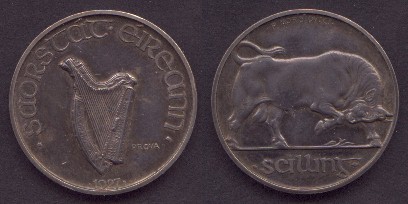
Morbiducci Pattern Shilling in Silver
The designs of Publio Morbiducci are the only patterns which were produced in metal, a very small number of examples were minted and some are in private collections.
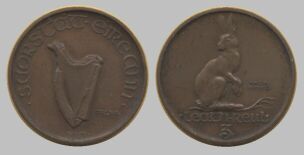
Morbiducci Pattern Threepence in Copper
The designs submitted by Percy Metcalf were awarded the prize and after some modifications to the submitted designs the coinage went into production in the Royal Mint in London.
Seven denominations were designed and produced and the first coins of each denomination were struck and issued dated 1928.
The Designs 1928-1969
Note: The harp side of a modern Irish coin is the obverse.
The animals appear on the reverse.
This is in-line with common numismatic terminology where the side with the monarch or symbol of the state is termed the obverse. For some reason the Irish coins are frequently described with an incorrect attribution of sides.
The reverse design of each coin has its denomination in Irish script as well as in numbers and also features the initials PM (Percy Metcalf) within the field.
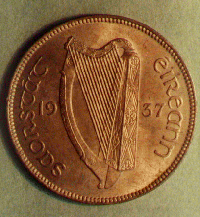 The common obverse (1928 to 1937)
The common obverse (1928 to 1937)
The design chosen for the common obverse was of a 16 string Irish harp modelled on the 'Brian Boru' harp in Trinity College Dublin. The legend Saorstat Eireann (Irish Free State, in Irish) surrounds, and the date is divided either side of the harp.
The obverse design caused some metal flow problems particularly associated with the penny and halfcrown reverses. This is why many 'Saorstat' pennies and halfcrowns in otherwise uncirculated condition show weakness at the top of the sound box on the right of the harp and occasionally in the halfcrown at the handle on the left of the harp.
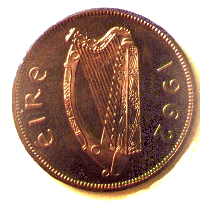 The common obverse (1938 to date)
The common obverse (1938 to date)
The change of the official name of the country from the Irish Free State to The Republic of Ireland in 1938 required a change in the legend on the obverse of the coin.
At the same time the harp was modified to impact the reverse design less and the legend was modified to Eire (Ireland in Irish) and the date was moved to one side of the harp.
The new design was introduced in 1939 but two pennies and one halfcrown are known dated 1938 which use the newer design. These coins are trial strikings in proof quality but without frosted fields.
|
|
|
The Denominations 1928 - 1969
The farthing (quarter of a penny)
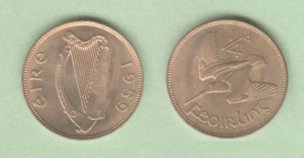
The animal chosen for the farthing is a woodcock in flight. Despite its diminutive size the woodcock was both an important game bird and an occasional addition to the table of the poorest agricultural labourer.
The farthing was first struck in 1928 and last struck for circulation in 1959. There was an additional issue in 1966, some of these 1966 farthings were used in the coin sets issued for the commemoration of the 50th anniversary 1916 rising.
The halfpenny
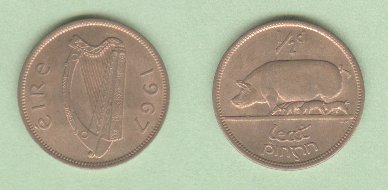
The animal chosen for the halfpenny is a sow with piglets. The pig was a very important animal in Irish rural life. Most families kept at least one animal which was fed on the kitchen refuse and other vegetable and animal scraps.
The halfpenny was first struck in 1928 and was last struck in 1967. It was demonetised on 31st December 1969 along with the halfcrown.
The penny
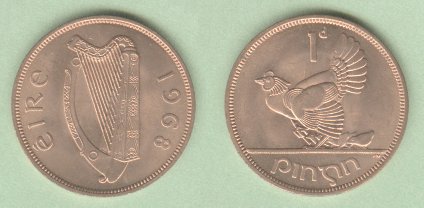
The animal chosen for the penny is a hen with chicks.
The design of the hen was altered slightly in 1938 to improve the flow characteristics of the metal under striking.
The penny was first struck in 1928 and was last struck in 1968. It was demonetised on the 18th of February 1971 along with the remaining denominations which had no counterpart in the decimal coinage.
The threepence
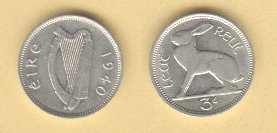
The animal chosen for the threepence is a hare.
The threepence was first struck in 1928, it was originally struck in nickel. The metal was changed to cupro-nickel in 1942 and it was last struck in 1968. It was demonetised on the 18th of February 1971 along with the remaining denominations which had no counterpart in the decimal coinage.
The sixpence
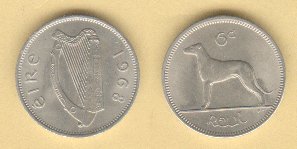
The animal chosen for the sixpence is an Irish wolfhound.
The sixpence was first struck in 1928, like the threepence it was originally struck in nickel. The metal was changed to cupro-nickel in 1942 and it was last struck in 1969.
There appears to have been an initial intention to retain the sixpence in its decimal equivalent of 2½ pence which explains its final striking date being later than the other coins in the series and in fact overlapping the first decimal issues in 1969. This plan never saw fruition and the sixpence was demonetised on the 18th of February 1971 along with the remaining denominations which had no counterpart in the decimal coinage.
The shilling (twelve pence)
The animal chosen for the shilling is a bull. The cow and the breeding of cattle was (and is) very important to Irish agriculture.
The shilling was first struck in 1928. The coin was originally struck in silver (750/1000). The final silver issue was in 1942. The 1951 issue was the first in cupro nickel.
There was a minor design change to the reverse in 1959 to improve the striking characteristics of the coin.
The shilling was last struck in 1968. It was succeeded in 1969 by the decimal 5 pence which had the same size, weight and basic design. The shillings continued to circulate as 5 pence pieces until 1992 when they were demonetised along with the original 5 pence and were replaced by a smaller coin.
The florin (two shillings)
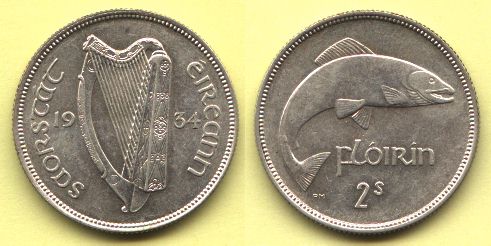
1934 - Florin
The animal chosen for the florin is a salmon. The fishing industry was (and is) very important to the Irish economy. The salmon represents both the sea fisheries and the freshwater game fishing.
The florin was first struck in 1928. The coin was originally struck in silver (750/1000). The final silver issue was in 1943. The 1951 issue was the first in cupro nickel. The decision to issue change the coin's metal content to cupro nickel was made before the 1943 coins were issued. So these coins and some of the 1942 coins were returned to the mint for melting. A small number escaped and these surviving 1943 florins are the great rarity of the modern Irish series.
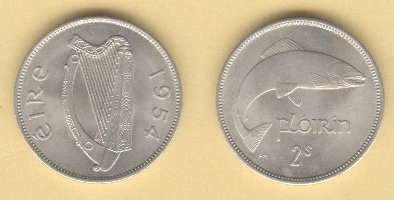
The florin was last struck in 1968. It was succeeded in 1969 by the decimal 10 pence which had the same size, weight and basic design. The florins continued to circulate as 10 pence pieces until 1993 when they were demonetised along with the original 10 pence and were replaced by a smaller coin.
The halfcrown (two shillings and six pence)
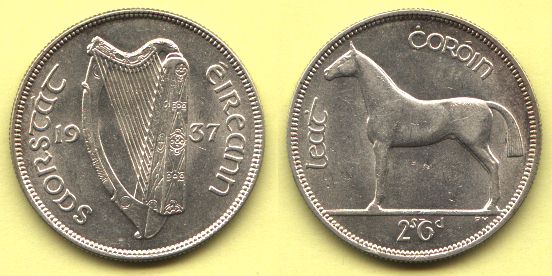
1937 Halfcrown
The animal chosen for the halfcrown is a horse.
The design was modified in 1938 to allow for better metal flow in the striking process. (see obverse design above).
A mule (a coin with mismatched sides) occurs in 1961 when an old die from the 1928-1937 coin was used to strike a small number of halfcrowns. The is the only major variety in the series (so far!).
(see -
Identifying a 1961 Mule halfcrown
)
The halfcrown was first struck in 1928. The coin was originally struck in silver (750/1000). The final silver issue was in 1943. The 1951 issue was the first in cupro nickel. The decision to issue change the coin's metal content to cupro nickel was made before the 1943 coins were issued. So these coins and some of the 1942 coins were returned to the mint for melting. A number escaped and these surviving 1943 halfcrowns are scarce. (illustrated -
1943 Halfcrown
)

1964 halfcrown
The halfcrown was last struck in 1967. It was demonetised on 31st December 1969 along with the halfpenny.
The Ten Shilling Piece
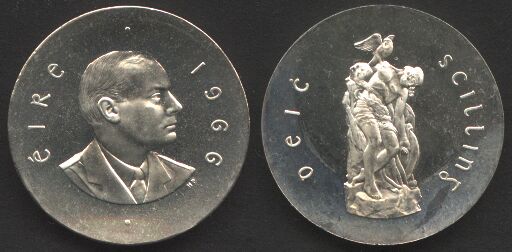
Pearse 10 Shillings - 1966 - Proof
In 1966, in an initial attempt at decimalisation, a ten shilling piece was introduced. Its design commemorates the Easter rising of 1916. Despite its patriotic design the coin was not popular and of the 2 million produced about 1 1/4 million were subsequently melted.
The Metals
The farthing, halfpenny and penny were struck in bronze at the same standard as the current English coins which were in circulation in Ireland at the time.
The threepence and sixpence were struck in nickel. They were similar in diameter but thicker than the circulating English coins which were of debased (50%) silver.
In 1942 the threepence and sixpence were changed to cupro-nickel which has better wear characteristics than nickel but which discolours more easily.
The shilling, florin and halfcrown were struck in .750 silver alloyed with .250 copper and at the same weight as the circulating English coins which were of debased (50%) silver. The earlier English sterling silver (925/1000) silver coins were still in circulation and remained so until the 1960's. So three standards of silver were in circulation in Ireland in 1928.
The decision to debase the three Irish silver denominations to CuNi was implemented in the coinage act of 1950.
This was realised in 1951 with the issue of a the shilling, florin and halfcrown in cupro-nickel in-line with the English currency which had been similarly debased in 1947.
The 1966 ten shilling piece was made of 833/1000 silver.
The 1943 rarities
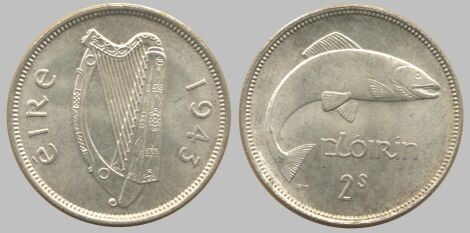
1943 Florin - UNC Specimen 2
The mintage figures for the 1943 florins and halfcrowns were similar to those for the immediately preceding years. However they were not issued before the decision to remove the silver content from the coins was made.
A large number of unissued silver florins and halfcrowns dated 1943 were returned to the Royal Mint for melting. Only a small number escaped and the florin is particularly rare. The florin was not discovered until 1968 by which time the Irish silver coinage was already being removed from circulation as the silver content had risen above its face value.
Despite the particular reason for the 1943 rarities it is worth keeping in mind that the 1930's saorstat issues are scarce in high grades. In particular the 1937 halfcrown in brilliant uncirculated condition is considered as rare a coin as the 1943 halfcrown and commands a similar price.
The eight coins in the modern series which could command prices above 1,000 dollars are :
-
The 1943 florin (rare in any grade)
-
The 1938 halfcrown (one known)
more info
-
The 1938 penny (two known)
more info
-
The 1943 halfcrown (in Unc or Brilliant Unc) - illustrated -
1943 Halfcrown
-
The 1937 halfcrown ( in Unc or Brilliant Unc) - Illustrated -
1937 Halfcrown - GEF
-
The 1937 shilling (only in Brilliant Unc)
-
The 1934 florin (only in Brilliant Unc)
-
The 1940 penny (only in Brilliant Unc)
The last of these coins (the 1940 penny) is relatively common in lower grades and quite easy to obtain in lustrous EF (US grading AU50), and is only really scarce in nice Uncirculated or better (US grade MS63+).
It is possible that the 1985 twenty pence piece will join this illustrious group. At the moment the number in existence is still a subject of speculation. However I have seen three examples (all of which were in my opinion genuine).
Decimalisation and Current Coinage (1969 to 2000)
The Irish Government decided to follow the international trend and adopt a decimal currency instead of the pound/shilling/penny or LSD system in the mid 1960s. Because the coinage circulating in Ireland comprised both British and Irish coins it was deemed prudent to introduce decimal coins at the same time as and with the same denominations as the British coinage.
'Decimal Day' was 15 Feb 1971. In fact the old and new currencies circulated together for three days (Monday, Tuesday and Wednesday) before the older coinage was demonetised.
It was briefly mooted that the sixpence would continue as a coin with a new value of 2½ pence (which explains its production in 1969) but this idea was shelved before decimalisation took place.
The new decimal 5 pence and 10 pence coins were identical in size and of equivalent value to the previous coinage, these coins were introduced early, in 1969, and the older counterparts were not demonetised.
The new 50 pence piece was introduced in 1970.
The decimal bronze coins were issued in reasonable quantities in 1969 and 1970 in sets of decimal coins to familiarise the population with the new coins. These early issues were dated 1971. There does not appear to be a method of distinguishing the 1969 and 1970 issues of these coins from the volume production in 1971.
The decimal sets with the 1969 dated 5 and 10 pence and the 1970 dated 50 pence contain bronze coins dated 1971 which were almost certainly the early production pieces.
The bronze coins : Halfpenny, Penny and Twopence
The designs for all three new bronze coins were new and prepared by Gabriel Hayes.
These coins were struck from 1969 and examples were available from that year, however these early strikings were all dated 1971 and indistinguishable from the actual 1971 issue.
From 1990 the two remaining denominations, the Penny and Twopence, were produced from copper plated steel which is significantly cheaper than the bronze which was previously in use.
The Halfpenny
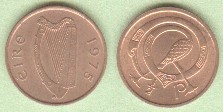
The design on the halfpenny is of a bird in a Celtic style with Celtic knot work panels inserted.
The halfpenny was issued from 1971 until 1986 when it was demonetised. The last issue for circulation was in 1982, by which time it had become redundant. The halfpenny was demonetised on January 1st, 1987.
The Penny

The design for the penny was another Celtic bird with some intricate knot work.
The Twopence

The design for the twopence was a Celtic bird with knot work in the field.
The Five pence
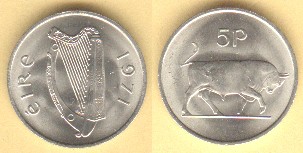

The design for the five pence was taken directly from the previous shilling. The shilling continued to circulate until the five pence was reduced in size and the larger coins and the remaining old shillings were withdrawn together in 1992. The new design also reversed the direction of the bull.
The Ten pence
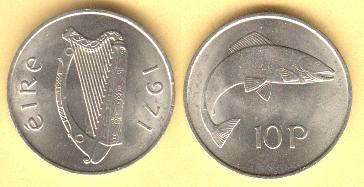
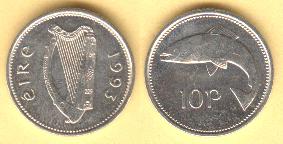
The design for the ten pence was taken directly from the previous florin. The florin continued to circulate until the ten pence was reduced in size and the larger coins and the remaining old florins were withdrawn together in 1993. The new design also reversed the direction of the salmon.
The Twenty Pence
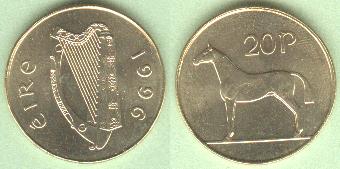
The twenty pence was not one of the original decimal issues. It was introduced in 1986. Its introduction also heralded the final separation of the Irish coinage from the British coinage. The legal separation took place in 1978 when the Irish pound joined the EMS (European Monetary System) and Sterling was kept outside. In 1982 the British coinage was augmented with a 20 pence and a pound which were not matched by similar coins in the Irish system. However it was not until the introduction of the Irish twenty pence in 1986 with an entirely different size, shape and metal content that the two coinages were fully separated.
The twenty pence also includes a potential rarity as it was struck in experimental numbers in 1985 and very few of these coins have been identified and found their way into collections.
The Fifty Pence
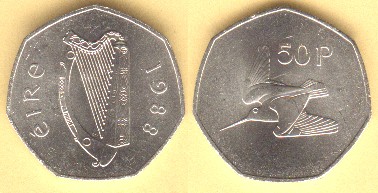
The fifty pence was introduced as a seven sided coin.
The seven sides are not straight, they are actually curved around the opposing corner which means the coin will roll easily. This seems counter-intuitive but it is true - try it!
The design is of a woodcock, which was the design used on the earlier farthing.
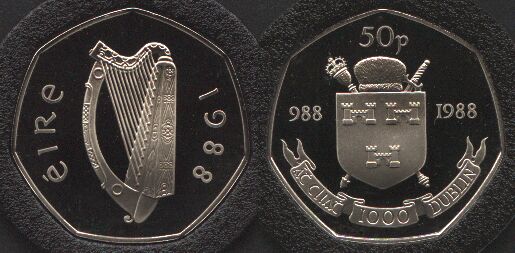
1988 Proof Dublin Millennium 50 Pence
The Fifty pence was used to carry the first commemorative design in the decimal series in 1988 with the Dublin Millennium celebration. In fact Dublin was much more than 1000 years old in 1988, it was a major commercial centre striking coins as early as 995AD
as will be seen elsewhere on these pages
, Dublin was actually founded no later than 840AD and probably much earlier.
The Pound

1990 Proof Pound Coin
The pound coin was introduced in 1990, replacing the pound note which becoming of too low a value to be cost effective as paper money. A proof striking was issued in a presentation case dated 1990.
The design for the pound coin is an Irish red deer - The design is very much in the style of Percy Metcalf's design for the 1928 coinage and was executed by Tomas Ryan. The design was also used on the Irish ECU coinage in 1990 where it is augmented with a mountain background.
The pound coin has an edge which is milled and subsequently engrailed. This process leads to errors and examples exist for each date with no engrailing on the edge. These are not real varieties as they are just mint errors (Most examples have evidence of the engrailing starting - at two opposite points in the rim).
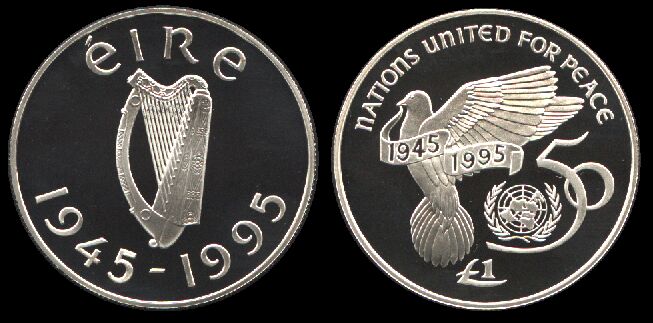
1995 UN Commemorative Pound
In 1997 The Central Bank issued a sterling silver proof pound coin dated 1995 to commemorate the 50th anniversary of the United Nations. This coin is larger than the circulating pound coin and no currency versions were made.
I believe that this coin was manufactured as one of a series of coins of similar size and weight produced by the Royal Mint to commemorate the 50th Anniversary of the UN. From the delay in the issue and the lack of any reference to Ireland on the early documentation for the set I speculate that either Ireland was not originally invited to take part (or that it was invited and declined the initial invitation) and under consideration subsequently joined the scheme.
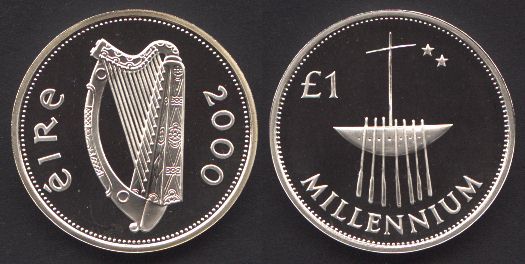
Millennium Pound - Silver Piedfort Proof
A millennium commemorative issue dated 2000 and with a design based on the broghter boat, an early Irish ornamental boat made in gold in the National Museum of Ireland has been issued. Silver piedfort proof coins have been made of this design.
 The common obverse (1928 to 1937)
The common obverse (1928 to 1937)
 The common obverse (1938 to date)
The common obverse (1938 to date)